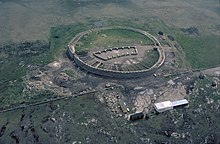Eketorp

Eketorp is an Iron Age hillfort, located on southeastern Öland, Sweden, and extensively reconstructed and enlarged in the Middle Ages.[1] Throughout the ages the fortification has served a variety of somewhat differing uses: from defensive ringfort, to medieval safe haven and thence a cavalry garrison.[2] In the 20th century it was further reconstructed to become a heavily visited tourist site and a location for re-enactment of medieval battles. Eketorp is the only one of the 19 known prehistoric fortifications on Öland that has been completely excavated, yielding a total of over 24,000 individual artifacts. The entirety of southern Öland has been designated as a World Heritage Site by UNESCO. The Eketorp fortification is often referred to as Eketorp Castle.
History[]



The indigenous peoples of the Iron Age constructed the original fortification about 400 AD, a period known to have engendered contact between Öland natives with Romans and other Europeans. The ringfort in that era is thought to have been a gathering place for religious ceremonies and also a place of refuge for the local agricultural community when an outside enemy appeared. The circular design was believed to be chosen because the terrain is so level that attack from any side was equally likely. The original diameter of this circular stone fortification was about 57 metres (187 ft). In the next century the stone was moved outward to construct a new circular structure of about 80 metres (260 ft) in diameter.[3] At this juncture there were known to be about fifty individual cells or small structures within the fort as a whole. Some of these cells were in the center of the fortified ring, and some were actually built into the wall itself.
In the mid 600s AD the ringfort was mysteriously abandoned, and it remained unused until the early 11th century. This 11th century work generally built upon the earlier fort, except that stone interior cells were replaced with timber structures, and a second outer defensive wall was erected.
Modern day situation[]
Presently the fort is used as a tourist site for visitors to Öland to experience a fortification for this region. A museum within the castle walls displays a few of the large number (26 000) of artefacts retrieved by the National Heritage Board during the major decade long excavation ending in 1974. Inside the fort visitors are greeted by employees wearing the correct costumes, from the period 400-650. There are daily activities during the summer season (mid Juni to mid August), which include bow and arrow, bread baking, guidings and many activities mainly towards children.
Eketorp lies a few kilometers west of route 136. There is an ample unpaved parking area situated approximately two kilometers west of the paved Öland perimeter highway. There is also a gift shop on site. During peak summer visitation, there are guided tours available. Visitors are assessed an admission charge.
Since 2019 the municipality of Mörbylånga is responsible for Eketorps borg. The first season was a great success with almost 39 000 visitors. In 2020 the fortress will open at Easter and will be open until late September and the Öland Harvest Festival.
See also[]
- Alby People
- Alvar
- Dry-stone wall
- Ringfort
- Stora Alvaret
References[]
- ^ Price, T. Douglas (2015). Ancient Scandinavia: An Archaeological History from the First Humans to the Vikings. Oxford University Press. p. 292. ISBN 978-0-19-023199-6.
- ^ K. Borg, U. Näsman, E. Wegraeus, The Excavation of the Eketorp Ring-fort 1964–74. In Eketorp Fortifikation and Settlement on Öland, Sweden, 1976
- ^ Eketorp Fortification and Settlement on Öland/Sweden: The Monument, Royal Academy of Letters History and Antiquities, 1976, 215pp
| Wikimedia Commons has media related to Eketorps fornborg. |
External links[]
Coordinates: 56°17′44″N 16°29′10″E / 56.29556°N 16.48611°E
- Buildings and structures completed in the 5th century
- Hill forts in Sweden
- Iron Age Europe
- Germanic archaeological sites
- Museums in Kalmar County
- Military and war museums in Sweden
- Historic house museums in Sweden
- Archaeological museums in Sweden

